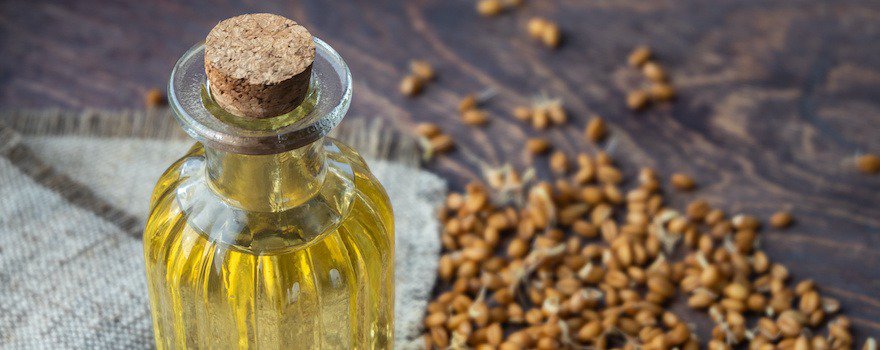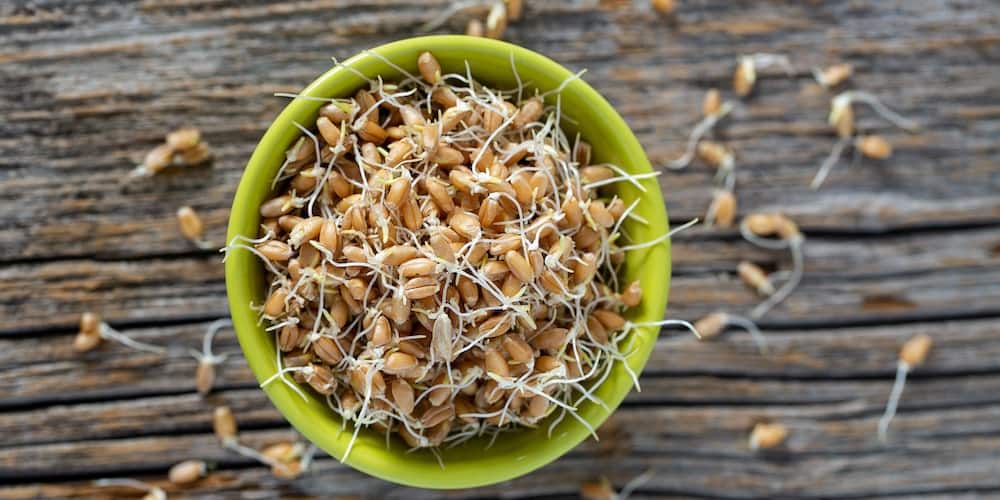BENEFITS OF WHEAT GERM
✓ Source of vitamin E
✓ Improves diabetes
✓ Relieves menstrual pain
✓ Enriches the microbiota
✓ Potentially anti-cancer
What is wheat germ?
Wheat germ is one of the 3 parts that make up the wheat grain (Triticum), a cereal plant from the grass family. Thus, we distinguish the bran (the protective cover), the endosperm (located in the heart of the grain), and the germ. The latter is called the “embryo” because it is from this that a new plant will emerge.
Except for the production of whole flour, the germ is separated from the endosperm and bran during the milling of wheat. Indeed, due to its richness in oils, it is prone to rancidity and can alter the taste of the flour.
Once separated, wheat germ is collected to be transformed into flakes, flakes, or vegetable oil.
Thanks to its highly nutritious composition, it has many health benefits. Its richness in vitamin E gives it antioxidant properties that protect the body from free radicals. Its consumption also helps to improve diabetes, relieve menstrual pain, and enrich the microbiota. Finally, it shows potential anti-cancer effects.
Nutritional Composition
- Amino acids
- Vitamins : B1, B2, B3, B5, B6, B9, C, E
- Minerals and trace elements : calcium, iron, magnesium, manganese, phosphorus, potassium, zinc, selenium
- Proteins
- Fiber
- Carbohydrates
- Fatty acids : omega-3, omega-6
- Antioxidant actives : phytosterols

The Benefits of Wheat Germ
🌿 Source of Vitamin E
Along with Brazil nuts, dried fruits, and fatty fish, wheat germ is one of the best natural sources of vitamin E (or tocopherol). Indeed, it contains no less than 16 mg of vitamin E per 100 g. This fat-soluble vitamin is present in the oils and fatty acids (omega-3 and 6) of the germ.
Vitamin E has an antioxidant action. It fights against free radicals and protects cells from oxidative damage and aging. In the germ, it protects oils from rancidity and oxidation. Vitamin E acts in the same way within the body by preventing the oxidation of lipids and fats by free radicals.
This review conducted by the Italian council for agricultural research and experimentation looked into the composition of wheat germ.
🍭 Improves Diabetes
With 15 g per 100 g, wheat germ is also a good source of dietary fiber. It notably contains soluble fibers that help with the control of blood sugar levels in cases of type 2 diabetes.
Soluble fibers slow down the absorption of carbohydrates (sugar) in the intestine and prevent glycemic spikes after meals. They also help reduce cholesterol and triglyceride levels, which are often high in diabetic individuals. Finally, they contribute to controlling appetite and weight.
This study from the Isfahan University of Medical Sciences (Iran), conducted on diabetic patients, demonstrates the benefits of wheat germ in improving diabetes.
🌺 Relieves Menstrual Pain
Like yarrow, wheat germ helps relieve painful periods or dysmenorrhea. Indeed, it has anti-inflammatory properties and alleviates symptoms associated with the menstrual cycle: fatigue, headaches, mood disorders…
It reduces the inflammation involved in menstrual pain. On the one hand, the vitamin E it contains lowers levels of pro-inflammatory cytokines. On the other hand, it contains vitamins, minerals, and trace elements useful for relieving pain and improving premenstrual symptoms. Notably, it contains magnesium and vitamin B6, which work synergistically to relieve painful muscle contractions and improve mental well-being.
This study from the Hamadan University of Medical Sciences (Iran), conducted on women, demonstrates the benefits of wheat germ in the treatment of dysmenorrhea.
♻️ Enriches the Microbiota
Thanks to its fiber richness, wheat germ has beneficial effects on the intestinal microbiota. Thus, like prebiotic foods, it promotes the development of good bacteria and relieves constipation.
Its regular consumption increases the intestinal bacterial population. Lactobacilli and bifidobacteria then become more numerous. At the same time, it reduces inflammation in the colon.
This study from Oklahoma State University (United States), conducted on mice, shows how wheat germ enriches the microbiota.
🔬 Potentially Anti-Cancer
In recent years, researchers have been interested in wheat germ and its potential anticancer activity. It is particularly used in the formulation of Avemar, one of the most studied dietary supplements intended for cancer patients.
On one hand, it interferes with the glucose metabolism used by cancer cells to proliferate. On the other hand, it stimulates the immune system and the activity of NK cells (natural killer cells). A comprehensive action that leads to apoptosis (programmed death) of cancer cells.
This study from the Bajcsy-Zsilinszky Municipal Hospital in Budapest (Hungary), conducted directly in the laboratory, demonstrates the interest of wheat germ in cancer prevention and treatment.

How to Consume Wheat Germ?
Wheat Germ in Flakes or Granules
Recovered during the milling of wheat, wheat germ is then offered in flakes or granules. Generally, we distinguish 2 types of wheat germ:
- Stabilized wheat germ: it has undergone a low-temperature thermal process aimed at preventing the oils it contains from rancidity. Thus, it can be kept longer (6 to 12 months) in a cool and dry place;
- Unstabilized wheat germ: the latter has not undergone any thermal treatment. It is therefore more fragile and can be stored in the fridge for up to 3 months.
The flakes or granules are easy to consume. Thanks to their light hazelnut taste, they pair with many savory or sweet recipes. You can sprinkle them on salads, raw vegetable dishes, add them to soups and broths, yogurts and cottage cheese… They will also enrich mueslis and smoothies.

Wheat Germ Oil
Wheat germ oil is obtained by cold pressing the germs. It is characterized by a beautiful yellow-orange color, a creamy texture, and an intense cereal taste. In cooking, it is used only for seasoning as its nutrients do not withstand cooking.
This oil is also interesting in cosmetics, for skin and hair care. Regenerating, nourishing, and protective, it is ideal for dry and mature skin.

Consume Sustainably: Choose Local, Organic, and Fair-Trade Wheat Germ
Wheat is one of the first crops to have been domesticated by humans, over 10,000 years ago in the Middle East. In France, it is the most grown cereal, ahead of corn and barley. Therefore, it is quite easy to find French-origin wheat germ locally. Also, choose wheat from organic farming and/or a fair trade sector to support the work of small farmers.
Dosage
It is recommended to consume 1 tablespoon of wheat germ per day.
Contraindications and Side Effects
The consumption of wheat germ presents some contraindications:
- Because it is high in calories, obese or overweight people should consume it in moderation;
- Due to its gluten content, it is not recommended for people with celiac disease.
Its consumption presents few side effects. Only an allergic reaction may occur in case of wheat sensitivity.
If you experience side effects, stop consumption and consult a doctor.
Article by Julia Perez
Sources and Scientific Studies
Andrea Brandolini, Alyssa Hidalgo, 2012. Wheat germ: not only a by-product.
Hamed Mohammadi, Mozhgan Karimifar, Zahra Heidari, Maryam Zare, Reza Amani, 2020. The effects of wheat germ supplementation on metabolic profile in patients with type 2 diabetes mellitus: A randomized, double-blind, placebo-controlled trial.
Maryam Atallahi, Sedigheh Amir Ali Akbari, Faraz Mojab, Hamid Alavi Majd, 2014. Effects of wheat germ extract on the severity and systemic symptoms of primary dysmenorrhea: a randomized controlled clinical trial.
Babajide A Ojo, Crystal O’Hara, Lei Wu, Guadalupe Davila El-Rassi, Jerry W Ritchey, Winyoo Chowanadisai, Dingbo Lin, Brenda J Smith, Edralin A Lucas, 2019. Wheat Germ Supplementation Increases Lactobacillaceae and Promotes an Anti-inflammatory Gut Milieu in C57BL/6 Mice Fed a High-Fat, High-Sucrose Diet.
András Telekes, Márta Hegedus, Chang-Hoon Chae, Károly Vékey, 2009. Avemar (wheat germ extract) in cancer prevention and treatment.
Gilles Charmet, 2011. Wheat domestication: lessons for the future.



